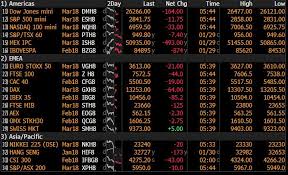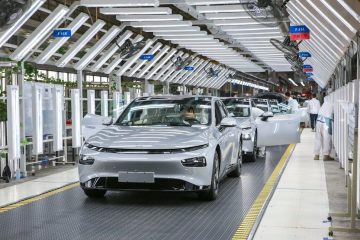Why Curbing Stock Buybacks Could Backfire

Share repurchases are getting a bipartisan pounding in Congress, where critics argue that such buybacks are bad for the overall economy. But the critics may have it backwards, because there’s evidence in the academic literature that corporate profits grow fastest when companies give more money back to shareholders, not less.
In the Senate, progressives Chuck Schumer (D-NY) and Bernie Sanders (I-Vt) have found common cause with Marco Rubio (R-Fla) in advocating legislation that would restrict buybacks, which in 2018 reached a record of over $ 800 billion, equivalent to around 75% of all S&P 500 profits.
(Read “Home Depot Plans $ 15 Billion Buyback After Polar Vortex and Government Shutdown Hit Earnings.”)
Schumer and Sanders argue that Congress should only allow repurchases when companies meet “minimum requirements” such as raising pay and benefits, while Rubio advocates eliminating buybacks’ tax advantage over dividends by raising the rate paid by investors who sell their shares back to the company. The opponents’ view is that since buybacks lower the proportion of earnings that companies retain and reinvest, the practice reduces capital spending on new plants, R&D, and fresh products, the crucial levers for boosting employment and wages. By undermining those levers, Schumer and Sanders argue, buybacks are a major driver of income inequality.
Both camps maintain that requiring or encouraging companies to plow a bigger share of their earnings back into the business would make companies grow faster and hire more workers. Restricting repurchases would “make their businesses more resilient [and] their workers more productive,” Schumer and Sanders recently stated in a New York Times editorial. And in a recent report issued by the Senate Small Business Committee, where he serves as chairman, Rubio contends that “cash spent on share repurchases is not cash spent on capital investment,” suggesting that restricting the practice would “channel the capital they represent more productively.”
Do profits grow when payouts shrink?
The anti-buyback camp maintains that getting companies to keep more of their earnings is better for workers and the economy than paying those earnings to shareholders and letting them determine where the cash goes. If that’s true, the assumption is that when enterprises retain a high proportion of their earnings, they make good use of the extra capital.
That’s not necessarily the case, according to a study from 2003 by two of the best minds in the world of finance. Each of the authors is a rare combination of a top academic and a force in asset management. Rob Arnott is the former editor of the Financial Analysts Journal, and founder of Research Affiliates, a firm that oversees strategies for $ 170 billion in mutual funds and ETFs for the likes of Charles Schwab and Pimco. Cliff Asness earned a PhD, and studied under Nobel laureate economist Eugene Fama, at the University of Chicago’s Booth School of Business, and is co-founder of AQR Capital Management, a $ 196 billion global investment management firm whose strategies are grounded in academic research.
The Arnott and Asness paper, entitled “Surprise! Higher Dividends = Higher Growth,” studied how the “payout ratio,” the portion of earnings companies return to shareholders in dividends, influences earnings growth. For the 55 years from 1946 to 2001, they took the payout ratio at the beginning of each month, then looked at the profit performance over the ensuing 10-year period, examining over 600 separate intervals.
Arnott and Asness didn’t deal directly with buybacks, which were a far smaller factor during the span of their study than they are today. Over that half-century, payouts to investors were dominated by dividends; today, they’re much more evenly divided between dividends and buybacks. What makes their paper relevant today is that they’re assessing how well companies deploy the earnings reinvested in their businesses––that is, how profitably they’re using the money that they don’t pay out to shareholders.
It would seem logical that the more profits companies reinvest––the higher the retention ratio and the lower the payout ratio––the faster their profits should grow.
But Arnott and Asness concluded the exact opposite. “The higher the payout ratio, the better the average subsequent earnings growth,” they found. They divided the periods into quartiles going from low to high payout ratios. For the one-fourth of the months when starting payouts were lowest (meaning companies were reinvesting the highest portion of their earnings) the average annual increase in inflation-adjusted profits over the next decade was a negative -.4%. The best 10-year period delivered only +3.2%, the worst a terrible -3.4%.
Conversely, the top quartile, collecting the 10-year periods with the highest starting payouts, delivered average annualized increases of 4.2%, and not a single negative reading. For several months in 1987, the S&P was returning over 60% of profits to shareholders and retaining around 40%, yet 10 years later, its members had generated average real profit increases of well over 6% annually. By 1990, the payout had dropped to roughly 45%, meaning the 500 members were reinvesting a much higher percentage of their profits. But earnings growth got bogged down, gaining only around 1.5% a year over the next decade.
The dangers of empire building
Why do corporate profits grow faster when big enterprises retain less cash? Arnott and Asness suggest several possible explanations––bearing in mind that these are theories, not backed by empirical data.
They acknowledge that high dividends, and large buybacks may express management’s confidence that future profits will be strong. Companies that opt to retain, say, only 50% of their profits because they can count on earning a 10% return on the reinvested cash, are in effect signaling that they’ll increase future profits more rapidly than a rival that keeps 100% and earns just 3% on the hoard it plows back.
Another theory is that “empire building” is to blame. When companies, especially mature players, keep a lot of cash, they may squander the extra capital on low-return investments that make them bigger, but not more profitable, including high-premium acquisitions that don’t deliver the advertised synergies.
The Asness-Arnott study is sixteen years old, and hence didn’t include the era of gigantic buybacks. Still, it’s worth asking whether if buybacks are restricted, the extra cash will be reinvested more profitably than if shareholders channeled the cash to the industries of the future.






